-
 Publications
Publications
-
 Research activities
Research activities
-
 Hybrid mobile hydraulics for excavators
Hybrid mobile hydraulics for excavators
-
 Lubricating Systems with Rotating Shafts
Lubricating Systems with Rotating Shafts
-
 0D models of axial piston pumps/motors
0D models of axial piston pumps/motors
-
 CFD studies on conical poppet valves
CFD studies on conical poppet valves
-
 CFD analysis of gerotor pumps
CFD analysis of gerotor pumps
-
 Lumped parameter models of crescent pumps
Lumped parameter models of crescent pumps
-
 Lumped parameter models of vane pumps
Lumped parameter models of vane pumps
-
 Lumped parameter models of gerotor pumps
Lumped parameter models of gerotor pumps
-
 Coupled simulation of telehandler hydraulics
Coupled simulation of telehandler hydraulics
-
 Modelling of brake booster vacuum pumps
Modelling of brake booster vacuum pumps
-
 Absorbed energy in ICE lubricating pumps
Absorbed energy in ICE lubricating pumps
-
 Multi-body simulation of axial piston pumps
Multi-body simulation of axial piston pumps
-
 Development of variable flow lubricating pumps
Development of variable flow lubricating pumps
-
 Optimization of ICE lubrication gerotor pumps
Optimization of ICE lubrication gerotor pumps
-
-
 Research projects
Research projects
Analysis of the absorbed energy in ICE lubricating pumps during a driving cycle (2008-2010)
Aim of this study is to contrast diverse types of ICE lubricating pumps using as screening factor the energy consumed during a standardized driving cycle. An accurate experimental procedure has been developed on a specific test rig for hydraulic pumps able to reproduce the operating conditions encountered during the driving cycle. Figure 1 shows a simplified layout of the test rig.
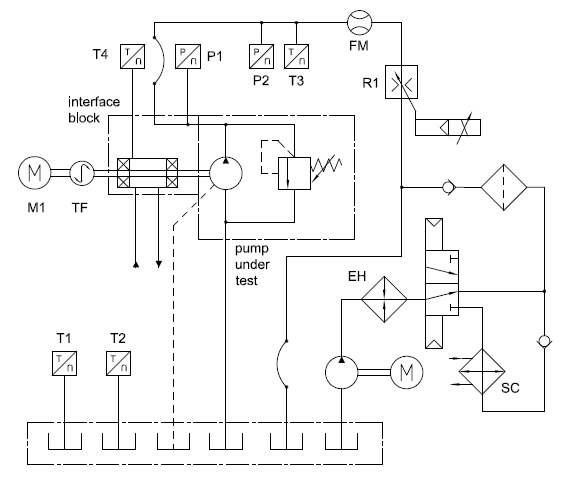 Figure 1
Figure 1
The steady-state characteristic of the lubricating circuit expressing the flow rate as function of pressure, temperature and speed can be reproduced by a closed loop control of the proportional throttle valve R1. The oil temperature profile measured on the engine can be replicated on the test rig acting on the power of the electric heater EH. A proper start up procedure allows the setting of the initial oil temperature at 20°C regardless of ambient conditions. The consumed energy is evaluated by integration of the product between the speed and the torque absorbed by the pump deprived of the contribution of the interface block.
In figure 2 a view of the rig from the operator control unit during a test is shown: in the monitor on the right the time-history of some measured quantities are displayed (flow rate, pressure, speed, torque, inlet and outlet oil temperature).
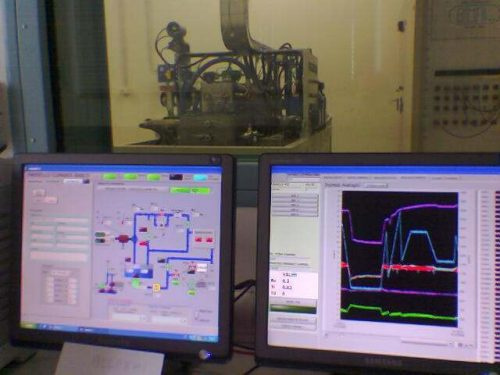 Figure 2
Figure 2
For gerotor (figure 3) and vane pumps the procedure has been also implemented in the LMS Amesim simulation environment (now Simcenter Amesim); in this case it is also possible to quantify the relative percentage contribution of each energy loss (friction, leakages, pressure relief valve and so on).
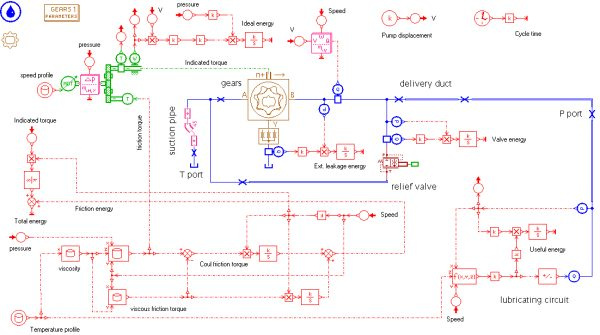 Figure 3
Figure 3
Figure 4 reports the comparison between some measured and experimental quantities during a NEDC driving cycle for a gerotor pump: the absorbed torque and the flow rate delivered to the lubricating circuit.
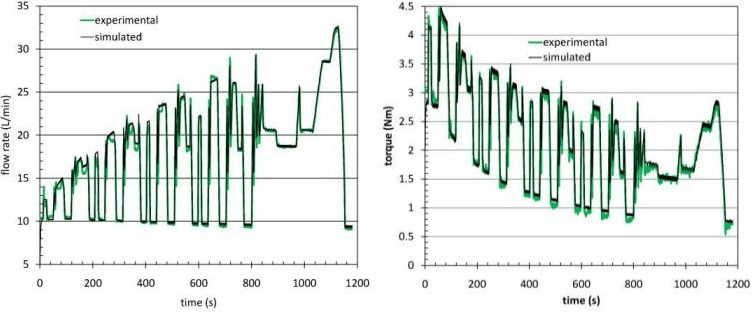 Figure 4
Figure 4
By means of a post-processing analysis it is possible to calculate the consumed energy during the NEDC cycle and the contribution of each cycle to the total absorbed energy. Figure 5 reports the consumed energies for three pump types as function of the time.
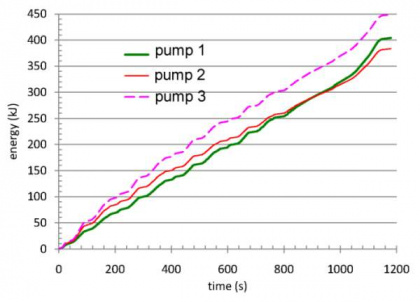 Figure 5
Figure 5
More details are available in:
RUNDO M, SQUARCINI R, 2009: Experimental Procedure for Measuring the Energy Consumption ...
RUNDO M, 2010: Energy Consumption in ICE Lubricating Gear Pumps
